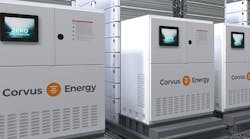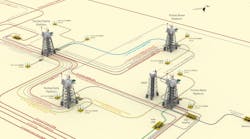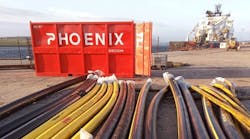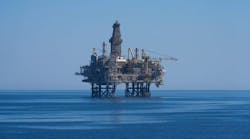Kvoerner, Dresser-Rand pursuing technology
Biphase turbine installed for tests at Texaco's Humble facility.
- Principle of operation used in biphase technology. The diagram illustrates the drag turbine concept. [13,473 bytes]
- Application of biphase technology to downhole separation. [13,823 bytes]
Since last autumn the company has been working closely in this field with Dresser-Rand Energy Systems through a jointly owned company, Multiphase Power and Processing Technologies LLC (MPPT), in which each has an equal share. For KPS, Dresser-Rand's willingness to make the substantial investment required to enter the venture indicates that it shares KPS's confidence in the significant potential of biphase technology.
Commercial applications already exist in the areas of geothermal power production and refrigeration. But there are ample opportunities for bringing it to bear with advantage on oil and gas activities, according to Simon Davies, technology vice president at KPS. Among these are two-phase and three-phase separation, downhole separation, wellhead power recovery and natural gas liquefaction.
"Biphase technology can be used to replace any process in which a pressure let-down step is followed by a requirement to separate a fluid into distinct components, based on density," says Davies. "In addition to separating components, it also captures the energy which conventional methods dissipate as the pressure is let down." The two main building blocks of a biphase turbine are:
- Two-phase inlet nozzle, in which pressure let-down takes place, and liquid and gas components are accelerated
- Turbine rotor, in which separation and energy transfer take place.
While the gas is drawn off through an outlet at the top of the turbine, the liquid is often taken out by a static scoop (called a diffuser), which can be designed to recover the remaining liquid kinetic energy as pressure. This energy could be made to work as a liquid pump, perhaps for water injection purposes, Davies says. As an alternative, liquids can be discharged from reaction jets in the turbine rotor, and drained from the burbine via a collection involute.
Compared with the conventional separation process, in which the fluid is flashed isenthalpically across the pressure let-down valve, the biphase turbine uses a near isentropic expansion process in which frictional heating is minimised. Since the shear intensity in the expansion nozzle is substantially less than that generated in a pressure let-down valve, the tendency for foaming and emulsion forming is considerably reduced in the biphase turbine compared with the conventional pro cess. This means that we should see a higher separation efficiency than achieved in gravity separators, and a more efficient chilling of products, says Davies.
Not only does the technology make available energy which is otherwise lost, but the energy itself is clean. It is not accompanied by any unwanted greenhouse emissions, or in fact, any emissions or waste.
A further advantage of biphase technology for the offshore industry is its compactness - whereas conventional separation technologies rely on gravity, which typically requires relatively long residence times in the order of some minutes, resulting in large and weighty separation vessels, the equipment for biphase separation processes fluids in a matter of seconds. Its compact dimensions make it interesting for reducing weight and space on new installations, for retrofitting into cramped areas, and eventually for using in subsea and downhole processes.
Turbine types
In terms of energy transfer, biphase turbines can divided into three types. In the drag turbine, the turning of the rotor is braked by an external load (generator, pump, compressor, etc.)in order to maximise the drag forces and increase the shaft power output - maximum efficiency of energy transfer is achieved when the speed of the rotor rim is half that of the impinging two-phase jet, which itself is typically 100-300 metres/second.In the reaction turbine, energy is additionally transferred to the rotor by reaction forces. Here, the liquid layer on the rotor rim is much thicker than on most drag turbines, which allows the outer part of the layer to be pressurized by the "hydrostatic head," while liquid is released through reaction nozzles set tangentially to the rotor surface.
In both drag and reaction turbines, the gas can also be passed through blading in the rotor rim, in order to transfer the kinetic energy it contains to the rotor. Reaction turbines are appropriate for handling streams containing solid particles, as the particles are slowed down in the thick liquid layer before they hit the rotor surface. The impact velocity of the solids can be further reduced by matching the reaction jet velocity to the rotor speed, thus minimizing the likelihood of erosion problems. In addition, solids will exit the turbine along with the liquid.
Thirdly, there is the impulse turbine, which was developed primarily for refrigeration duty and is more directed to efficient energy generation than separation. Here, the fluid jet impinges directly on a set of turning vanes, which changes in flow direction, transferring energy to the rotor. The separation of phases occurs as the liquid moves across the turbine blades.
KPS's involvement in biphase technology goes back to 1993, when it began cooperating with Biphase Energy Company (BECO), the company which developed and owned the technology prior to its being acquired by MPPT. But, as progress in developing oil and gas applications has advanced through desk studies to demonstration projects, it has increasingly felt the need for greater expertise in rotating machinery to complement its own separation expertise. It was to fill this gap, that Dresser-Rand became involved.
MPPT is now managing the further development and commercialization of the technology, and KPS has retained the rights and responsibilities of selling oil and gas applications on behalf of MPPT. MPPT will sell the technology in other areas and both companies will share manufacturing and packaging of turbines as appropriate.
The biphase turbine was originally developed to separate the water and steam flowing from geothermal wells, and at the same time to provide the energy to drive a generator and thus augment the energy produced from the well by means of the stream turbine. In a commercial demonstration project carried out in Mexico, the energy output from one such well was increased by 40% by the introduction of a 30-in biphase turbine.
Test run
The first major test of the technology in an oil and gas context came last year when a demonstration unit was run at Texaco's Humble test facility in Houston as part of a joint industry project (JIP). The unit, which has a 24-in pipe inlet, with the capacity to handle 20,000 b/d of oil and 20 MMcf/d of gas.The turbine was designed to demonstrate that efficient separation can be achieved in a biphase turbine. The measured separation efficiencies ranged from 99.41% to 99.88% during variation of mass flow, gas-oil-ratio, water cut in liquid phase, temperature, and rotational speed.
The pressure recovery potential in the liquid diffuser was also demonstrated at the highest liquid flow rate in the test program. At 68.2 cu meters/hr of liquid flow, a stable discharge pressure of 30.2 bar above the turbine's separation pressure was recorded. This was 20.2 bar above the turbine inlet pressure.
The unit, which now has had gas blading fitted in order to improve its power recovery potential, is due to undergo further testing this year, either at Humble or in a North American oil field. This unit gives a good illustration of the compactness of the technology.
The turbine itself has an outer casing of about one metre in diameter and 0.75 meters in length. Including the inlet piping and motor/ generator, the package is between one third and one quarter of the size of the separator vessel it replaces.
Another good example of the technology's compactness is the design developed by MPPT for a rotary scrubber. Here, the biphase turbine for an 8-in pipe with the capacity to process 11 MMcf/d of gas and remove 220 b/d of liquids is just 2-3 ft long and light enough to be bolted into the pipe without requiring any additional support, says Davies. This product is now ready for field testing.
The technology offers considerable weight and space saving potential. A desk study performed by KPS and BECO indicated, in the case of a high-pressure condensate field, a potential weight saving of 63%, a space saving of 60%, recovered energy of 2,000 kW, and for a high-pressure oil field, weight and space savings of 55% and 50% respectively.
Range of applications
The compactness makes the technology suitable for downhole separation. To take the example of a gas well suffering increasing water inflow, a biphase turbine could be used to knock out the liquids and, using their remaining kinetic energy plus some of the energy in the gas, a diffuser scoop could be used to pump them back into a suitable place in the formation. This would let the gas flow unhindered up the wellbore. The idea is still at the conceptual stage, but has aroused enough interest from the industry to be under consideration for a JIP, says Davies.Another very interesting area is the application of the technology to natural gas liquefaction. An added benefit of flashing in the biphase turbine is that more cold liquid refrigerant is produced than by flashing across a valve. This fact, combined with the technology's compactness and potential for process simplification, has also attracted the interest of oil companies, Davies says.
The technology is already in commercial use in industrial refrigeration. Carrier Corporation in the US produces a 500-ton chiller incorporating a 6-in biphase turbine developed by BECO, which processes 41,000 kg/hr at an inlet pressure of 8 bar. The turbine has an efficiency of 55%, the highest yet attained for a two-phase turbine operated with a flashing liquid. For chilling in oil and gas processes, propane, ethane, and ethylene circuits are candidates for application, Davies says.
Wellhead power recovery is another attractive area, which has particularly aroused interest in Norway. Here KPS has carried out a series of studies for Saga Petroleum, and developed the design for a 4 MW package. Other major operators are now also showing interest in taking this work forward.
The flexibility of biphase turbines is enhanced by their wide operating envelope: design have been established to process flows of 5,000-150,000 b/d per unit, power recovery from 20 kW to 4 MW per unit, rate of revolutions from 1,000 to 10,000 rpm, and separation forces of 1,000-5,000 g.
There are also plans to further developed biphase technology to handle three-phase separation in a single process, Davies says. Initial proof of concept tests have been carried out in the laboratory with very encouraging results, and MPPT has plans to build an oil field demonstration unit this year.
As an addition to wellhead power recovery, it is now becvoming apparent that dw point control may be of more interest in locations where power recovery has few benefits. The conbination of the Well Stream Power Recovery Turbine and a Dress-Rand compressor provides a compact liquid separation and dewpoint control unit with no additional energy requirements, the system also allows for a moderate increase in liquid yield. One of the true benefits of the alliance is access to specific compressor technology as well as rotating equipment design.
Copyright 1999 Oil & Gas Journal. All Rights Reserved.






